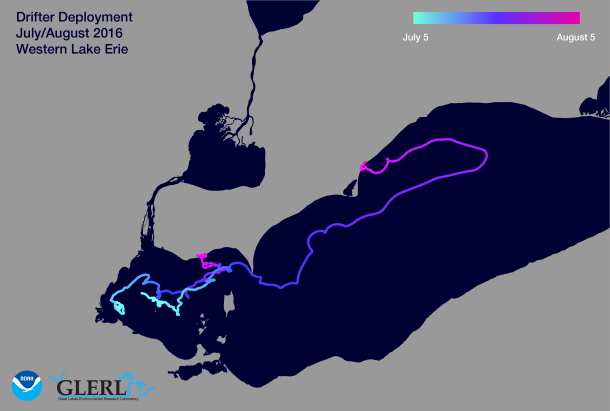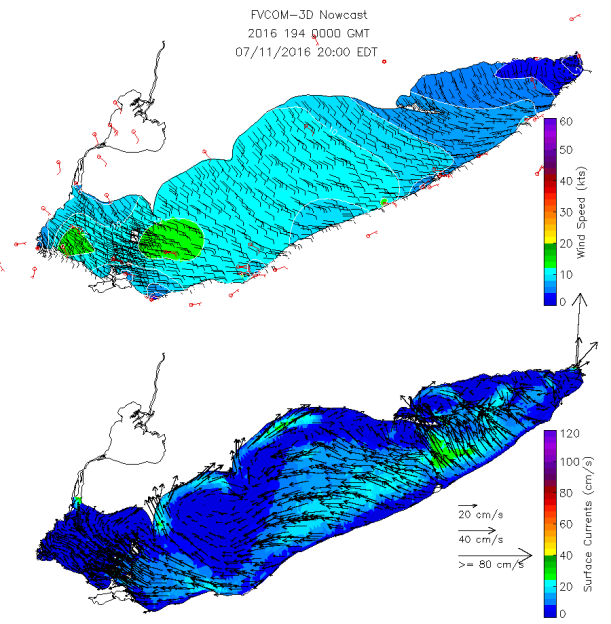In a new study, scientists from GLERL, the University of Michigan, and other institutions take a new look at changing ice cover and surface water temperature in the Great Lakes. The paper, set to be published in Climatic Change, is novel in two ways.
While previous research focused on changes in ice cover and temperature for each lake as a whole, this study reveals how different regions of the lakes are changing at different rates.
While many scientists agree that, over the long term, climate change will reduce ice cover in the Great Lakes, this paper shows that changes in ice cover since the 1970s may have been dominated by an abrupt decline in the late 1990s (coinciding with the strong 1997-1998 winter El Niño), rather than gradually declining over the whole period.
—
NOAA tracks ice cover and water surface temperature of the Great Lakes at a pretty fine spatial scale. Visit our CoastWatch site and you’ll see detailed maps of surface temperature and/or ice cover updated daily.
However, when studying long-term changes in temperature and ice cover on the lakes, the scientific community has used, in the past, either lakewide average temperature data or data from just a few buoys. We knew how each lake was changing overall, but not much more.
Now, for the first time, researchers are using our detailed data to look at the changes happening in different parts of each lake.
Using GIS (geographic information system) analysis tools, researchers calculated how fast ice cover and temperature were changing on average for each of thousands of small, square areas of the lakes (1.3 km2 for ice cover, and 1.8 km2 for temperature).
The maps below show the results. Changes in ice, on the left, are reported in the number of days of ice cover lost each year. Temperature changes are reported in degrees Celsius gained per year.

Panel a shows the change in seasonal ice cover duration (d/yr) from 1973 to 2013, and panel b shows the change in summer surface water temperature (°C/yr) from 1994 to 2013. Maps from Mason, L.A., Riseng, C.M., Gronewold, A.D. et al. Climatic Change (2016). doi:10.1007/s10584-016-1721-2. Click image to enlarge.
The researchers also averaged these values across major subbasins of the lakes. Maps of those results are below. The color coding is the same, and again, ice cover is on the left while temperature is on the right.
Note: These subbasins aren’t random, and were outlined by scientists as a part of the Great Lakes Aquatic Habitat Framework (GLAHF), which is meeting a need (among other things) for lake study at intermediate spatial scales.

The panel on the left shows the change in seasonal ice cover duration (d/yr) from 1973 to 2013, and the panel on the right shows the change in summer surface water temperature (°C/yr) from 1994 to 2013. Maps created by Kaye LaFond for NOAA GLERL. Click image to enlarge.
Depth, prevailing winds, and currents all play a role in why some parts of the lakes are warming faster than others. A lot of information is lost if each lake is treated as a homogenous unit. With so much variation, it may not make sense for every region of the Great Lakes to use lakewide averages. Studying changes at a smaller scale could yield more useful information for local and regional decision makers.
—
The second part of the story has to do with how ice cover has changed in the lakes. Previous studies typically represent changes in ice cover as a long, slow decline from 1973 until today (that would be called a ‘linear trend’). However, when looking at the data more carefully, it seems the differences between the 70’s and today in many regions of the Great Lakes are better explained by a sudden jump (called a ‘change point’).
The figure below shows yearly data on ice cover for the central Lake Superior basin. It is overlaid with a linear trendline (the long, slow decline approach) as well as two flat lines, which represent the averages of the data before and after a certain point, the ‘change point’.

Annual ice cover duration (d/yr) for the central Lake Superior basin, overlaid on the left with a linear trend-line, and overlaid on the right with a change-point analysis. Graphic created by Kaye LaFond for NOAA GLERL. Click image to enlarge.
Statistical analyses show that the change point approach is much better fit for most subbasins of the Great Lakes.
So what caused this sudden jump? Scientists aren’t sure, but the change points of the northernmost basins line up with the year 1998, which was a year with a very strong winter El Niño. This implies that changes in ice cover are due, at least in part, to the cyclical influence of the El Niño Southern Oscillation (ENSO).
All of this by no means implies that climate change didn’t have a hand in the overall decline, or that when there is a cyclical shift back upwards (this may have already happened in 2014) that pre-1998 ice cover conditions will be restored. The scientific consensus is that climate change is happening, and that it isn’t good for ice cover.
This research just asserts that within the larger and longer-term context of climate change, we need to recognize the smaller and shorter-term cycles that are likely to occur.


![drifters map 2 [Converted]-01.png](https://noaaglerl.blog/wp-content/uploads/2016/07/drifters-map-2-converted-011.png?w=611)

